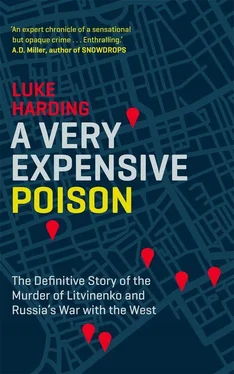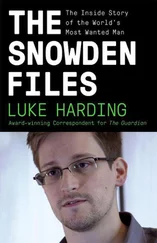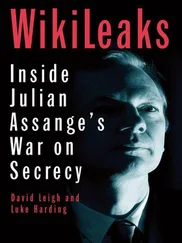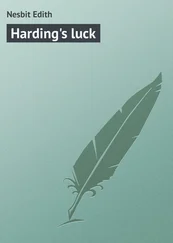Litvinenko was aware his time was running out. His friend Zakayev had been visiting him in hospital every day; they had talked of Chechnya, religion and Zakayev’s Muslim faith.
Litvinenko told Zakayev: ‘One day when I die, will you promise to put my body in Chechen ground?’ Zakayev agreed – given the circumstances, it would have been impossible to refuse. A precondition of burial was that Litvinenko convert to Islam. Zakayev asked Marina if he could bring an imam. She assented; the imam visited intensive care and performed the ceremony at speed.
Litvinenko’s father Walter flew in from Moscow and arrived at his son’s bedside. Litvinenko informed him: ‘Dad, what do you think? I’ve converted. I’m now a Muslim.’
Walter was an Orthodox Christian. In his later years he’d become more of a believer. He took this development in his stride. And replied: ‘It doesn’t matter, at least you’re not a communist.’
By the next day, Wednesday, 22 November, doctors treating Litvinenko had scrapped their diagnosis. Their notes read: ‘We DO NOT feel this gentleman has or had inorganic thallium poisoning.’
At midday, a top-level meeting was convened at the Metropolitan Police’s counter-terrorism command. It involved SO15 detectives, led by Detective Superintendent Timmons, medical staff, a scientist from the UK’s Atomic Weapons Establishment, the Forensic Science Service and Dr Nick Gent from Porton Down, the UK’s military science facility. The latest urine test had revealed the presence of a new radioactive isotope – polonium-210. But this was marked down as an anomaly, caused by the plastic container used to carry Litvinenko’s urine.
According to Timmons, the specialists discussed five theories which might explain Litvinenko’s baffling poisoning. Most were esoteric. They included Stevens– Johnson syndrome, an idiosyncratic reaction to drugs; an intake of cytotoxins, cancer-fighting medicines; and exposure to an external radiation source, such as cobalt-30. Another possibility was natural causes. Or an internal radiation source, such as polonium. This last theory was seen as unlikely. The experts decided to investigate further and to send a litre of urine to Aldermaston.
Back in the intensive care ward, Litvinenko was drifting in and out of consciousness. The Russian-German filmmaker Andrei Nekrasov visited him. Nekrasov had previously conducted several interviews with Litvinenko; he shot the video on condition that it would be released only with Marina’s approval. It’s the last photograph. Litvinenko lies on his bed, a vanquished soul, around whom the world is closing and darkening. A drip is attached to his nose; his cheeks are hollow; his eyes are open – just. There is pale afternoon light.
‘He was conscious, but was very, very weak,’ Marina said. ‘I spent almost all day sitting close to him, [to] make him just be calm and more relaxed.’ At 8 p.m. Marina got up to leave, and told her husband: ‘Sasha, unfortunately I have to go.’
She said: ‘He smiled so sadly, and I started to feel I’m guilty because I’m leaving him, and I just said, “Don’t worry, tomorrow morning I will come and everything will be fine.”’
Litvinenko whispered back to her: ‘I love you so much.’ Marina wanted to exit on an optimistic note; she joked that she hadn’t heard those words for a long time.
At midnight the hospital called to say that Litvinenko had gone into cardiac arrest, not once but twice. They managed to resuscitate him. She returned to University College Hospital, getting a lift with Zakayev, and found her husband unconscious and on a life-support machine. She spent the following day, 23 November, at his side; Litvinenko was in an induced coma. That evening she went back to Muswell Hill. An hour after arriving home the phone rang. It was the hospital telling her urgently to return.
Litvinenko suffered a third cardiac arrest at 8.51 p.m. The consultant on duty, Dr James Down, tried to revive him but at 9.21 p.m. pronounced life extinct. When Marina and Anatoly arrived at the hospital they were taken not to the ward but to a side-room. Ten or fifteen minutes later, the doctor told them that Litvinenko was dead. He added: ‘Would you like to see Sasha?’, to which Marina replied: ‘Of course.’
For the first time in several days, she said, she was allowed to touch and kiss him; Anatoly ran from the room after half a minute.
Six hours before Litvinenko’s death, at about 3 p.m., Timmons received a phone call from the Atomic Weapons Establishment. It had the results from the latest tests. They confirmed that Litvinenko was ‘terribly contaminated’, as Timmons put it, with radioactive polonium.
7
Ruslan and Lyudmila
Mayak nuclear complex, Ozersk, Russia, 1952–2006
‘On the curved strand a green oak grows’
RUSLAN AND LYUDMILA , ALEXANDER PUSHKIN, 1820
Every good Russian student knows the beginning of Alexander Pushkin’s much-loved mock-epic poem Ruslan and Lyudmila. It concerns a young prince, Ruslan, whose bride Lyudmila is seized from him on his wedding night by an evil dwarf, Chernomor. To get her back, Ruslan has to go on a knightly quest. Along the way he defeats a rival suitor. He meets a giant talking head and finds a golden sword.
The dwarf, meanwhile, tries in vain to woo Lyudmila, his prisoner. She manages to disappear using an enchanted hat. There is fighting. Ruslan grapples with Chernomor as they fly through the air. He later rescues Kiev from enemy attack. And there is a happy ending, with a little help from healing water and a magic ring.
The poem begins in a translation by Peter France:
On the curved strand a green oak grows
On the green oak a golden chain
And on it round and round there goes
The cat of knowledge, night and day –
Goes to the right and sings a ditty,
Goes to the left, begins a tale.
Published in 1820, the mock-heroic fairy tale made the young Pushkin famous. He started writing it at the age of seventeen, a student at the lyceum near St Petersburg. He finished it three years later, a junior official at the ministry of foreign affairs. The poem is playful, luminous, sparse and strange. Pushkin admired Lord Byron; Ruslan and Lyudmila has witty and colloquial touches reminiscent of the British poet.
It is also a very Russian work. It blends elements from Russian folklore and ordinary life; as well as a fantasy garden there is a scene in a bathhouse. It’s subtle, too. Pushkin both enters into this fairytale universe and simultaneously stands outside and coolly assesses it. The low-tonality vowels of the opening have a haunting quality. What emerges is a new and vibrant literary language.
In the Soviet Union every educated citizen read Pushkin’s epic verse at school. So, it was unsurprising that scientists working at a Soviet nuclear facility deep in the Urals decided to call two of their nuclear reactors there ‘Ruslan’ and ‘Lyudmila’. The names were playful, half-nodding towards the strange and magical world of nuclear science. ‘Ruslan’ and ‘Lyudmila’ was also a lively, if ghoulish, shorthand – a way of referring to the clandestine work that went on inside the guarded perimeter fence. The Mayak complex was top secret, like other state institutions engaged in the assembly of nuclear weapons. What better way of defusing Mayak’s threat than jolly familiarity? In Russian, mayak means ‘lighthouse’, humorous given its invisibility.
The two reactors were built at the tail end of the Soviet Union. Ruslan is a pool-type light water reactor that has operated since 1979, undergoing a major overhaul in 1998–9. Lyudmila is a heavy water reactor that has been in operation since 1988. Lyudmila is bigger, with a power of 1,000 megawatts.
Читать дальше












